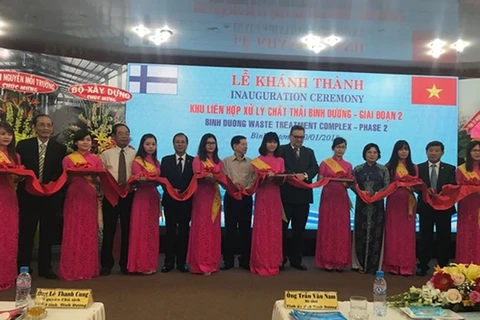Hanoi (VNS/VNA) – The fact that waste is not classified at source was the biggest challenge to treating it in Vietnam, experts said.
Vu Thi Vinh, former General Secretary of the Association of Cities of Vietnam, said the volume of waste is rising, raising the need for proper management otherwise the health of the whole community is at risk.
It was calculated that a total of 15.6 million tonnes of solid waste was collected nationwide in 2015. This has increased 9 percent per year, in line with the economic growth rate. In other words, the amount of waste rises is parallel with the people’s living standards.
About 30 percent of the total collected volume in rural areas is treated at fertiliser production units - and the remaining 70 percent is buried directly.
The common practice of solid waste management in Vietnam is landfilling.
However, only 120 sites surveyed met the hygiene standard, according to a 2017 report from Japan International Cooperation Agency.
The country had 660 landfills with scale of more than 1ha by the end of 2016, it said.
Specifically, most of waste at landfills is not classified at source. They occupy a lot of land, generating large amounts of waste water due to a lack of a collection and treatment system.
The report also revealed that landfills were overloaded and 179 out of 407 sites in the survey have capacity to receive waste within four years.
Addressing a forum on innovative technological solution of solid waste management toward low-carbon economy held in Hanoi earlier this week, Vinh said the report was a warning. She also underlined the importance of choosing the right waste treatment technology suitable with each region.
Phung Chi Sy, Deputy Director of the Vietnam Association for Conservation of Nature and Environment, said waste-to-energy is considered a new trend in Vietnam.
Many localities including HCM City, Hanoi and Can Tho have granted or considered granting licences to waste-to-energy plants.
Waste-to-energy technology is considered by HCM City authority as the main solution as it is expected that the volume of solid waste treated by this technology will increase to 55 percent by 2020 and 85 percent by 2030.
The city currently treats 8,900 tonnes of solid waste per day, with around 69 percent buried, according to the HCM city’s Department of Natural Resources and Environment. Every day, it also treats 1,500 tonnes of industrial waste, 374 tonnes of hazardous waste and 22 tonnes of medical waste.
Nguyen Toan Thang, Director of the department, said that domestic waste in the city was projected to increase between 6-8 percent per year. It means that more than 10,000 tonnes will be discharged each day by 2020 and 16,500 tonnes by 2030. With the technology, more than 200MW (megawatts) of electricity could be generated between 2019-2030 period.
To attract investors, the city said it would offer preferential policies such as 70 percent reduction of land rent, land for infrastructure, price support for energy pricing, support of loan interest, and favourable tax policies.
Over the past several years, waste-to-energy from developed countries such as the US, Denmark, Netherlands, Spain, the Republic of Korea, Japan have been importing in to Vietnam. It has been applied in a number of waste treatment projects in some localities through foreign investment or Official Development Assistance.
However, most of these plants have failed to meet expectation or run at full capacity.
The main reason was that garbage did not classified at source, Vinh told Nguoidothi.net.
To improve the effectiveness of solid waste treatment, she said it was necessary to have a policy and detailed plan to boost sorting garbage at source.
She also said favourable conditions should be offered to private investors engaged in solid waste treatment plants.
Nguyen Quang, Director of United Nations Human Settlements Development Programme in Vietnam (UN Habitat Vietnam) shared the views, saying much attention should be paid to the community’s role in sorting of waste at the source because it will reduce the costs of waste treatment.
“A financial mechanism was needed to encourage private investors to pour money in technology to handle daily activities,” he said.
According to Pham Chi Sy, in comparison with other technology, waste-to-energy has a lot of advantages including reducing 90-95 percent of volume, utilising of energy, water pollution and greenhouse gas emission reduction.
“With high capital and operating costs which is 4-6 times higher than current burial technology, preferential policies for waste-to energy technology can be a big motivation to attract investors,” he said.
Because 60 to 80 percent of waste is organic one with high humidity at average 50 -60 percent or up to 80 percent in rainy season, and the fact that garbage not sort at source, it is costly – between 50-75 USD to treat 1 tonne of waste, Sy added.-VNS/VNA
VNA

























